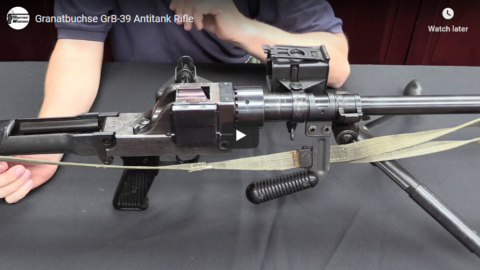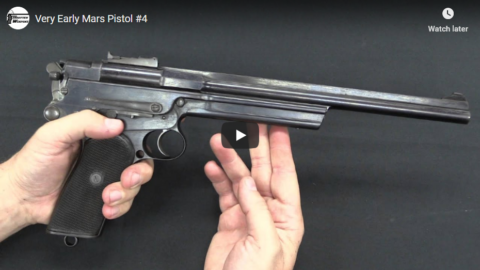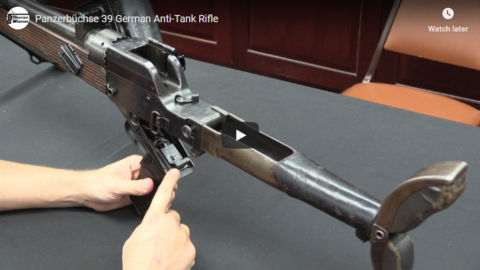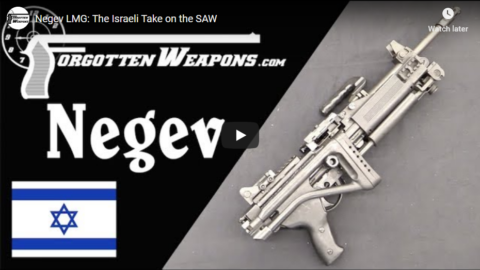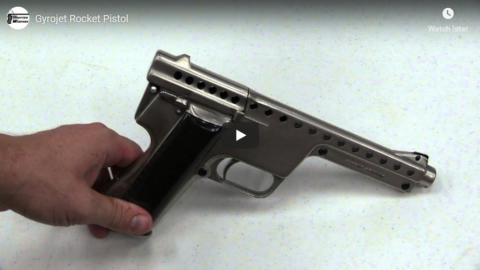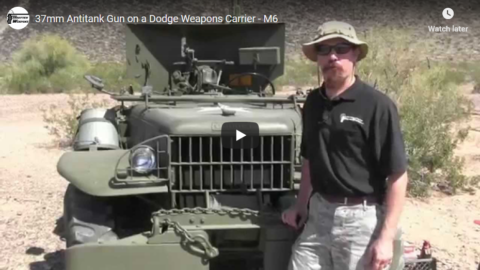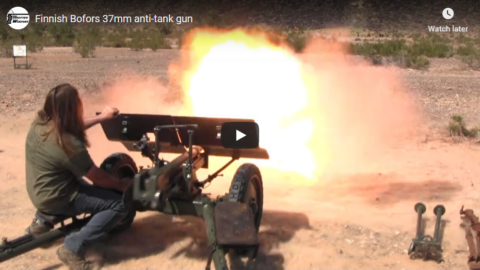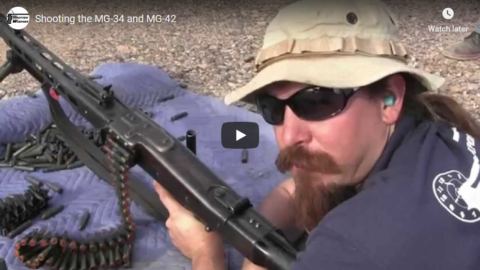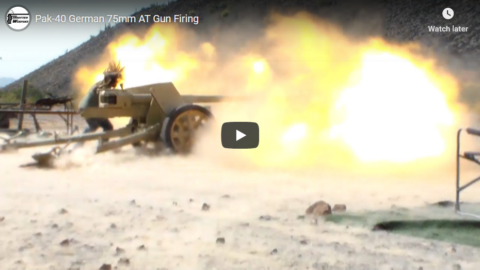Forgotten Weapons
Published on 8 May 2019Preorders now open for my book, Chassepot to FAMAS: French Military Rifles 1866-2016! Get your copy here: https://www.kickstarter.com/projects/…
http://www.patreon.com/ForgottenWeapons
Cool Forgotten Weapons merch! http://shop.bbtv.com/collections/forg…
The Owen submachine gun is one of the ugliest SMGs ever designed, and yet also one of the most beloved by its users. The original basis for the gun was a .22 rimfire submachine gun designed by 23-year-old Australian Evelyn Owen. That prototype was found by his neighbor Vincent Wardell after Owen left for military service. Wardell was the manager of Lysaght Works, an engineering firm, and thought that the gun might be the basis for a useful military SMG. As it turned out, he was right – it became the standard SMG of The Australian military through World War Two and the Korean War, and was one of the best such guns of that period. For more details on the history of the Owen, see my full article:
https://www.forgottenweapons.com/subm…
Thanks to Movie Armament Group in Toronto for giving me the opportunity to bring you this video! Check out MAG on Instagram: https://instagram.com/moviearmamentsg…
Contact:
Forgotten Weapons
PO Box 87647
Tucson, AZ 85754
July 13, 2019
Local Boy Saves Nation: The Australian Owen SMG
July 10, 2019
An Overview of the Pinfire Revolver System
Forgotten Weapons
Published on 4 May 2019(Video reuploaded to removed an allegedly copyrighted still image)
http://www.patreon.com/ForgottenWeapons
Cool Forgotten Weapons merch! http://shop.bbtv.com/collections/forg…The pinfire system was an early cartridge type which saw widespread use in Europe, but was not widely adopted in the United States. First invented by a French designer named Pauly, it was made commercially feasible by Casimir Lefacheaux. It was Casimir’s son Eugene, however, who took the pinfire cartridge to its full potential, garnering a French military contract in the 1850s and building Lefacheaux into one of the largest French/Belgian non-government arms manufacturers in the mid 1800s.
Todays we are looking at an assortment of pinfire revolvers, to get some basic idea for the sort of variety that was made over the decades. Small to large, plain to fancy, and with all manner of quirky details (like folding bayonets and Lefacheaux’s triple-action fire control system).
Contact:
Forgotten Weapons
PO Box 87647
Tucson, AZ 85754
July 7, 2019
Granatbuchse GrB-39 Antitank Rifle
Forgotten Weapons
Published on 29 Aug 2015http://www.patreon.com/ForgottenWeapons
Hammer price: $13,000
Like most countries, Germany had a standard-issue antitank rifle when World War II began — the Panzerbuchse 39. It fired an 8 x 94mm cartridge with a small very high velocity armor-piercing bullet. And like the other AT rifles from the 1930s, the PzB-39 became obsolete quickly as tank armor improved during the war. However, while most countries simply scrapped their antitank rifles, the Germans opted instead to convert the guns into dedicated grenade launchers.
Because the PzB-39 was already designed for a very high pressure cartridge, it was ideally suited to handle the stresses of firing large anti-tank grenades. Rather than relying on simple kinetic energy to penetrate, the grenades could use shaped charge technology to be vastly more effective than AP bullets.
In converting the PzB-39 into the GrB-39, the barrels were cut down, grenade launching cups attached to the muzzles, new sights designed for grenade use, bipods lengthened, and the folding stocks were fixed in place. Most of the PzB-39 rifles in service were subject to these modifications, and the resulting GrB-39 guns were able to be reasonably effective through the end of the war.
July 4, 2019
Gyrojet Carbine, Mark 1 Model B
Forgotten Weapons
Published on 27 Aug 2015http://www.patreon.com/ForgottenWeapons
Hammer price: $3,000
The Gyrojet was one of the more creative and one of the most futuristic firearms innovations of the last few decades – unfortunately it wasn’t able to prove sustainable on the market.
The idea was to use burning rocket fuel to launch projectiles, instead of pressurized gas. The advantage was that without the huge pressure of standard cartridges, a rocket-firing gun could be made far lighter and cheaper, as it had no need to contain pressure. The rockets would accelerate down the barrel as their fuel burned (and the 4 rocket jets would be angled to put a spin on the projectile for accuracy), and the weapon would actually have the most kinetic energy at something like 20 yards downrange, when the fuel was expended.
A decent number of Gyrojet handguns were made and sold (mostly as curiosities), but intrinsic accuracy problems prevented them from ever being taken seriously as weapons. The company behind the guns (MB Associates) went out of business shortly, unable to fully exploit their full range of ideas. One of those ideas was a carbine variant of the gun. A few hundred were made in two different models, and we have the chance today to take a look at one of the Mark 1 Model B sporter-style carbines.
July 1, 2019
Very Early Mars Pistol #4
Forgotten Weapons
Published on 17 Apr 2015Sold for $46,000.
Until the midle of the 20th century, the most powerful automatic pistol made was Sir Hugh Gabbett-Fairfax’s Mars pistol. With the .45 caliber version approaching the energy of a .45 Winchester Magnum, it was quite the accomplishment for a gun designed initially in 1898! Well, RIA has a very early example of the Mars – serial number 4 – coming up for sale. This gun (chambered for the .360 Mars cartridge) has a number of features that differ from the more “typical” Mars pistols (all 80 or so that were ultimately made). These include a very long barrel, a tangent-style rear sight, and a 3-lug bolt instead of the standard 4-lug type. A very cool pistol to have a look at!
June 28, 2019
Panzerbüchse 39 German Anti-Tank Rifle
Forgotten Weapons
Published on 7 Apr 2015Sold for $37,375.
Most countries still had anti-tank rifles in their military inventory at the beginning of WWII – the Solothurn S18-100, the Lahti L39, the Boys AT Rifle, the PTRD and PTRS, and so on. For Germany, this role was fulfilled by the Panzerbüchse 39, a single-shot falling block rifle firing a high velocity 8mm AP cartridge. It was nominally effective in the opening campaigns of the war, but was quickly rendered obsolete as Allied armor improved. German planners has a huge number (25,000) of these on hand for the invasion of Russia, where they expected Russian armor to be vulnerable to them – which was not the case. Most were subsequently converted into Granatbüchse 39 AT grenade launchers, which were then used until the end of the war.
Cool Forgotten Weapons Merch! http://shop.bbtv.com/collections/forg…
June 25, 2019
Mars Automatic Pistols
Forgotten Weapons
Published on 1 Mar 2015Sold for:
$74,750 (.45 cal example)
$40,250 (8.5mm example)The Mars pistol was designed by Sir Hugh Gabbett-Fairfax in England in 1898, and only 81 were produced by the time manufacturing ended in 1907. These pistols were chambered for several different cartridges, all of them tremendously powerful for the day (and really not equaled by another self-loading pistol until the Automag).
Cool Forgotten Weapons Merch! http://shop.bbtv.com/collections/forg…
Theme music by Dylan Benson – http://dbproductioncompany.webs.com
I first heard of these pistols in one of L. Neil Smith’s first SF novels, and they sounded so over-the-top that I assumed he’d made them up for the story. This is a fascinating piece of hand artillery that I’d be terrified to have pointed at me (but I’d probably be nearly as terrified to shoot).
June 23, 2019
Shooting the Negev LMG
Forgotten Weapons
Published on 22 Jun 2019My first book is available for pre-order; check it out!
https://www.headstamppublishing.com/f…http://www.patreon.com/ForgottenWeapons
Cool Forgotten Weapons merch! http://shop.bbtv.com/collections/forg…
After yesterday’s look at the history and mechanical details of the Israeli Negev LMG, today we are taking it out the the range.
It certainly is a very pleasant experience to shoot! The recoil is very light, although not as light as in a true constant-recoil system like the new Knight’s LAMG. As you can see in the high speed footage, the bolt carrier clearly does impact the back of the receiver with each shot. Still, it has a simple gas adjustment, a very easy barrel-changing system, excellent sights, and runs well on both magazines and belts.
Many thanks to Movie Armaments Group in Toronto for the opportunity to showcase their Negev for you! Check them out on Instagram to see many of the guns in their extensive collection:
https://instagram.com/moviearmamentsg…
Contact:
Forgotten Weapons
PO Box 87647
Tucson, AZ 85754
June 22, 2019
Negev LMG: The Israeli Take on the SAW
Forgotten Weapons
Published on 21 Jun 2019My first book is available for pre-order; check it out!
https://www.headstamppublishing.com/f…http://www.patreon.com/ForgottenWeapons
Cool Forgotten Weapons merch! http://shop.bbtv.com/collections/forg…
When the Israeli Defense Forces tested the FN Minimi, they found it to be lacking in a few areas, and decided that they could develop a better SAW domestically. Developed in the 1980s, the result was the Negev. Like the Minimi, the Negev is a 5.56mm light machine gun that can feed from either belts or box magazines (Galil mags or AR mags with an adapter), has quick-change barrels, and fires from an open bolt. The Negev has several features the Minimi does not, though, including a semiauto fire control position, optics mounting on the receiver (instead of the top cover), a standard folding stock, and some mechanical improvements internally.
So, let’s dig into this Negev and see how it ticks!
Many thanks to Movie Armaments Group in Toronto for the opportunity to showcase their Negev for you! Check them out on Instagram to see many of the guns in their extensive collection:
https://instagram.com/moviearmamentsg…
Contact:
Forgotten Weapons
PO Box 87647
Tucson, AZ 85754
Gyrojet Rocket Pistol
Forgotten Weapons
Published on 8 Sep 2014http://www.forgottenweapons.com
The Gyrojet was the closest thing to a commercially successful rocket pistol, although not many were sold before the company went out of business. This is the 13mm pistol version (the most common type of Gyrojet), and fires a 180 grain rocket projectile. It was for sale – with 15 rounds of live ammunition – at the Rock Island Premier Auction in September. Hammer price on it was $5500.
Theme music by Dylan Benson – http://dbproductioncompany.webs.com
June 19, 2019
37mm Antitank Gun on a Dodge Weapons Carrier – M6
Forgotten Weapons
Published on 1 Jun 2014http://www.forgottenweapons.com
Theme music by Dylan Benson – http://dbproductioncompany.webs.com
The M6 Gun Motor Carriage was the first American tank destroyer of WWII – a 37mm antitank gun (basically identical to the M3 gun) mounted on the back of a Dodge 3/4 ton weapons carrier. A large armor shield protected the gun crew from small arms fire, but the vehicle was otherwise highly exposed. The truck was powered by a flathead 6-cylinder engine producing 99 horsepower, and had a top speed of 55 mph. The gun was effective and modern in the late 1930s when its design process began, but was underpowered and insufficient by the time the M6 first saw action in 1942/3 in Tunisia.
Not many complete M6 carriages remain in existence today, as they were replaced quickly after their poor showing in North Africa. Most had the guns removed and were converted back into utility trucks, while some were used by the Free French forces and some saw use in the Pacific theater (where the underpowered gun was less of a concern).
June 16, 2019
Finnish Bofors 37mm anti-tank gun
Forgotten Weapons
Published on 27 Apr 2014Cool Forgotten Weapons Merch! http://shop.bbtv.com/collections/forg…
Theme music by Dylan Benson – http://dbproductioncompany.webs.com
The Swedish Bofors company developed a sophisticated and very high-quality light anti-tank gun in the early 1930s, and found significant commercial success with it. A variety of countries either purchased the guns outright from Bofors or paid for licenses to produce them domestically. These countries included Denmark, Finland, Poland, the Netherlands, and Sweden itself. The largest number were in Poland (1200 or more), and there is speculation that some may have been sold to Spain during the Spanish Civil War (both these guns and a 40mm AA gun which definitely went to Spain were designated wz.36). A significant number were also captured and reused by German and Russian forces during WWII. On the Allied side, some of the guns were sold to the Sudan and used by British forces in North Africa (generally mounted on trucks).
The gun itself was an excellent design, capable of 12 rounds/minute of accurate fire and potent enough to deal with most of the smaller tanks in existence at the beginning of WWII. New tank developments made it obsolete, but it was at least effective against Russian light tanks (BT, T-26, T-28) in the Winter War if not the heavier T-34s. The gun has a sophisticated suspension system to help absorb recoil energy, and fired a 37 x 257mm shell with a 740g projectile at about 825 m/s (26oz @ 2700 fps). The action was semi-automatic, meaning that once fired, the action would recoil on the carriage, and automatically eject the empty case. It would then return to battery with the breech open, ready for a new shell to be loaded (in the video, the ejection mechanism has been disabled to help preserve the brass cases).
June 13, 2019
Shooting the MG-34 and MG-42
Forgotten Weapons
Published on 11 May 2014Cool Forgotten Weapons Merch! http://shop.bbtv.com/collections/forg…
Theme music by Dylan Benson – http://dbproductioncompany.webs.com
The MG-34 and MG-42 machine guns were the mainstay of German infantry (and vehicle) firepower during World War II, and it will take several videos to properly cover them. For now, we are shooting them both, and explaining how to load, unload, and operate them (including changing barrels on the MG42). Enjoy!
June 10, 2019
Pak-40 German 75mm AT Gun Firing
Forgotten Weapons
Published on 30 Mar 2014Cool Forgotten Weapons Merch! http://shop.bbtv.com/collections/forg…
Intro music by Dylan Benson – http://dbproductioncompany.webs.com
While we normally stick to small arms here, this beast of a gun was just way too impressive for me to not pay attention to. I was at a cannon and machine gun shoot just recently where some folks brought out what is (I believe) the only functional Pak-40 in the United States. And shot it.
The Pak-40 was the backbone of German antitank guns during WWII, and fired a 75mm AP shell out to an effective range of about a mile in a direct-fire role, with enough energy to defeat pretty much any Allied tank except the late-war Russian heavies. It was fairly light weight given its effectiveness, and makes one hell of a concussion when fired.
Thanks to the gun’s owners for being awesome!
June 7, 2019
Bren Gun at the Range
Forgotten Weapons
Published on 23 Aug 2011We take a 1940 Bren gun to the range to demonstrate function, disassembly, and shooting from a variety of positions. For more information, check out http://www.ForgottenWeapons.com .



